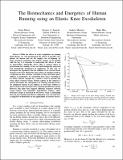The biomechanics and energetics of human running using an elastic knee exoskeleton
Author(s)
Elliott, Grant; Sawicki, Gregory S.; Marecki, Andrew; Herr, Hugh M
DownloadHerr_The-Biomechanics.pdf (2.138Mb)
OPEN_ACCESS_POLICY
Open Access Policy
Creative Commons Attribution-Noncommercial-Share Alike
Terms of use
Metadata
Show full item recordAbstract
While the effects of series compliance on running biomechanics are well documented, the effects of parallel compliance are known only for the simpler case of hopping. As many practical exoskeletal and orthotic designs act in parallel with the leg, it is desirable to understand the effects of such an intervention. Spring-like forces offer a natural choice of perturbation for running, as they are both biologically motivated and energetically inexpensive to implement. To this end, we investigate the hypothesis that the addition of an external elastic element at the knee during the stance phase of running results in a reduction in knee extensor activation so that total joint quasi-stiffness is maintained. An exoskeletal knee brace consisting of an elastic element engaged by a clutch is used to provide this stance phase extensor torque. Motion capture of five subjects is used to investigate the consequences of running with this device. No significant change in leg stiffness or total knee stiffness is observed due to the activation of the clutched parallel knee spring. However, this pilot data suggests differing responses between casual runners and competitive long-distance runners, whose total knee torque is increased by the device. Such a relationship between past training and effective utilization of an external force is suggestive of limitations on the applicability of assistive devices.
Date issued
2013-06Department
Massachusetts Institute of Technology. Department of Electrical Engineering and Computer Science; Massachusetts Institute of Technology. Department of Mechanical Engineering; Massachusetts Institute of Technology. Media Laboratory; Program in Media Arts and Sciences (Massachusetts Institute of Technology)Journal
2013 IEEE 13th International Conference on Rehabilitation Robotics (ICORR)
Publisher
Institute of Electrical and Electronics Engineers (IEEE)
Citation
Elliott, Grant et al. “The Biomechanics and Energetics of Human Running Using an Elastic Knee Exoskeleton.” IEEE, 2013. 1–6.
Version: Author's final manuscript
ISBN
978-1-4673-6024-1
978-1-4673-6022-7
ISSN
1945-7898